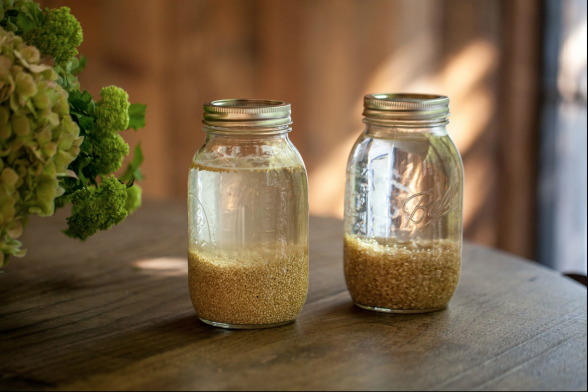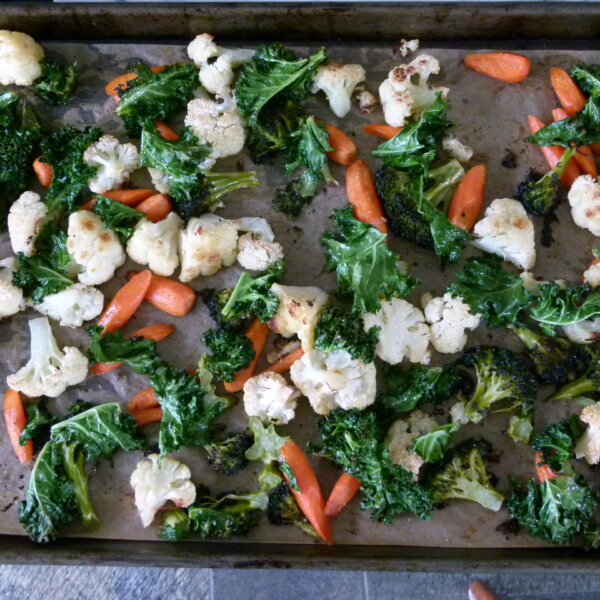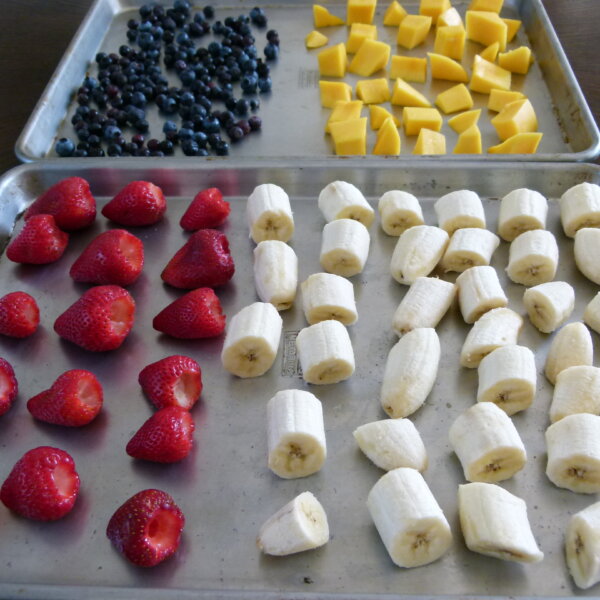
Jenni Kayne asked me to share with her readers one of her favorite tips that I have taught in class — soaking grains. So we have collaborated on a today’s post! Do check out her amazing lifestyle website, ripplustan.com which is one of my favorite sources for learning about new products, entertaining ideas and of course, fashion!
I am a big fan of a mostly plant-based diet and more importantly, I emphasize as many whole, unprocessed foods as possible. Whole grains can definitely be part of a healthful diet, but they are much more nutritious and digestible when prepared the way our ancestors did by soaking, fermenting or sprouting them before cooking or eating.
Whole grains contain an anti-nutrient called phytic acid which binds with certain minerals (e.g. zinc, phosphorous, calcium and iron) and prevents them from being absorbed by the body. Phytic acid is also very hard on the digestive system. Most of the phytic acid is contained in the exterior bran and germ layers of the grain. Ironically, whole grains are much higher in minerals than polished or refined grains, but we won’t receive those benefits unless we neutralize the phytic acid.
Phytic acid is also an enzyme-inhibitor which keeps the grains/seeds dormant until the conditions for germination are just right. Not only does phytic acid prevent seeds from sprouting, it also helps protect them from predators by blocking digestive enzymes so that the seeds stay untouched as they pass through our digestive tract.
Soaking, fermenting or sprouting your grains before cooking them will neutralize the phytic acid and release the enzyme inhibitors, thus making them much easier to digest and making the nutrients more assimilable. Phytic acid can be neutralized in as little as 7 hours when soaked in water with the addition of a small amount of an acidic medium such as vinegar or lemon juice. Soaking also helps to break down gluten, a hard-to-digest protein found in grains such as wheat, spelt, rye and barley.
Fortunately, grains are very easy to soak. You just need to start the process the night before or the morning of the day you want to eat them. Pour grains into a bowl and cover with warm or room temperature filtered water. Add a tablespoon of something acidic, such as yogurt, raw apple cider vinegar, lemon juice, whey or kefir, for example. Cover and allow to sit at room temperature for at least 7 hours or longer. Change the water after 24 hours if you’re still soaking. Drain and rinse the grains before cooking with fresh water.
Even though 7-8 hours is the minimum recommended for soaking, even a few hours is better than nothing. An extra benefit to soaking grains is a shorter cooking time. The longer you soak them, the less time is needed to cook and also less water. There’s no formula to figuring this out, but usually if you soak 1 cup of brown rice for 8 hours, you can reduce the cooking time from 50 minutes to about 40 and use about 1/3 cup less water. For 1 cup of soaked quinoa, you can cook for about 10 minutes and use 1 ½ cups of water.
If you’ve been eating whole grains, nuts and seeds for years without soaking, don’t stress. A small amount of phytic acid is reduced just by the cooking process alone. But for minimal effort, you can significantly improve the digestibility and nutrition of these important foods.











Hi Pamela! .. A most interesting article, thank you! .. I am wondering why you recommend rinsing grains after soaking them? I currently incorporate a range of ‘dry’, whole seeds (chia, quinoa, amaranth, flax and millet) in my sourdough bread, that ferment inside the dough for 5 hours at room temp, and then another 12-18 hours in the fridge, before baking. I was working under the assumption that the lactic and acetic acids in the dough would work to neutralize the phytic acid in the seeds (and the flour) during that time .. Is that an incorrect assumption? Thank you!
Hi Pamela. You said that soaking grains in water with addition of an acid will neutralize the phytic acid. From what I learned in school, what neutralizes an acid is actually a base, and not another acid. Its confusing. Please comment on this. Thank you very much.
I think I can answer your question, Gerrie.
Acids & Bases are on a spectrum and are so named due to where they fall generally on the pH scale which relates to Hydrogen concentration. For instance water can be either an acid or a base depending on what other chemical it is reacting with. Whichever chemical is MORE acidic–having a higher concentration of Hydrogen Ions–will be the acid, giving up Hydrogen Ions. Likewise the MORE basic chemical in the reaction–having a lower concentration of Hydrogen Ions–will receive those Hydrogen Ions from the acid.
So the terminology of “Acid” vs “Base” depends on each specific reaction & the strength (in this case the Hydrogen concentration) of those specific chemicals with respect to one another. When we’re mixing several acids together, some of those acids are stronger or weaker than the others–again, on that spectrum of Hydrogen concentration–so the stronger acids act like acids and the weaker acids act as bases.
My B.S. detector just went off. Acids are proton donors. Bases are proton acceptors. No amount of a lesser acidic substance is going to neutralize a more acidic substance. It just doesn’t work that way. You will simply dilute the more the more acidic substance, but never neutralize it.
Secondly your stomach acid is way more concentrated in terms of pH. Short of drinking lye, you’re not going to neutralize that acid. So the idea of eating foods that are less acidic and more alkaline to improve your health is pure bunk. Your kidneys are responsible for regulating the pH of your blood.
Thank you for the info! I have been on a paleo + AIP diet for over a month and am eager to start adding grains back in. This is how I’ll do it. This process goes for all types of beans, too, correct? Another question: if I want to ferment as opposed to soak, do I just lengthen the time? How will I know when it’s fermented enough?
Yes, that’s correct. The same method applies to all types of beans. To ferment grains, soak in water and add a splash of acid (vinegar, lemon juice, kefir, kombucha). Store at room temperature for 6 to 12 hours, or longer if it’s convenient. You can also break down larger grains in a spice grinder (just slightly to expose the interior) and this can help ferment them faster.
What do you think about freezing grains after they’ve been soaked but are still raw? I saw your comment about cooking and then freezing, but wondered if it would be ok to just freeze immediately after soaking? Thanks!
Oooh, not sure I would recommend that. If you’re not ready to cook them, you can keep changing the water every 8 hours until you are. Or drain, rinse and refrigerate for a day or two until you can cook them.
Thanks for your reply! Curious why you wouldn’t recommend it?
Because I’ve never done it and never seen it done!;). I know you can freeze raw grains and cooked grains, but I really don’t know if you can freeze them once they’ve been soaked. I don’t know if it would affect the texture. If you try it, please let me know how it turns out!
Ah ok thanks!
Tried it with barley and added it to a soup. Didn’t seem to change the texture.
I have soaked oats, then cooked and frozen for a couple of years now. I freeze them in serving size batches. For breakfast or for soup l simply get one or two servings out of the freezer and a couple of minutes later breakfast is ready. I strictly use oat groats.
I soak and then freeze my grains all the time. They boil up very well and faster.
Oh, good to know. I think that’s a great idea! Thank you for sharing, Max.
Whenever I soak brown rice or quinoa for 24 hours and then rinse it, it gets almost gummy and starchy when I cook it. Am I doing something wrong? Thanks!
It sounds like you are not reducing the water. When you soak grains, you need less water and less time to cook them.